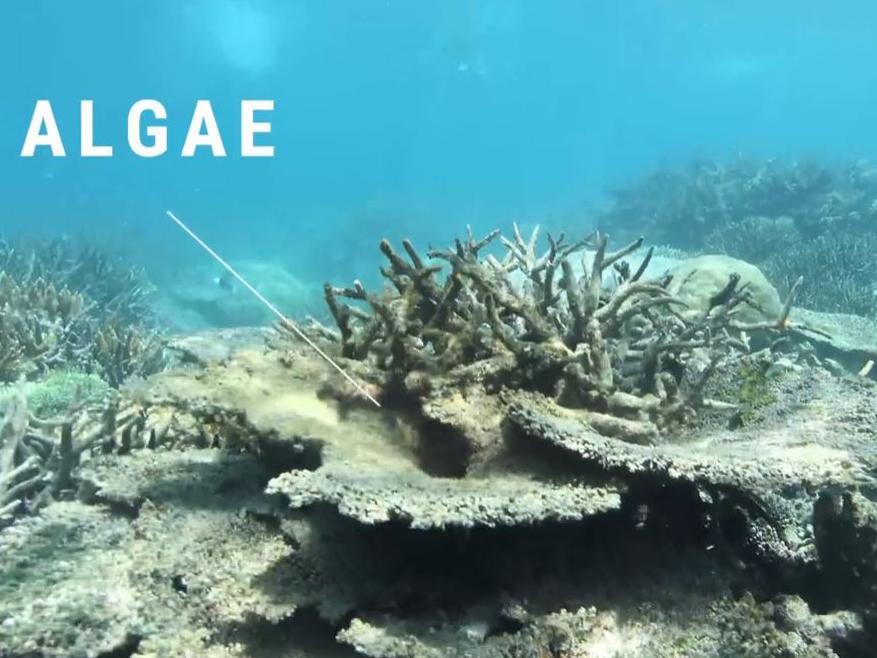New pictures show Great Barrier Reef is not repairing itself as it should
'If it was a person, it would be on life support'
New images of the Great Barrier Reef have revealed the extent of the damage climate change has caused to the coral.
The world’s largest reef system, which stretches for over 1,400 miles off the coast of Australia, has been severely affected by rising water temperatures.
In May, researchers found more than a third of corals in central and northern parts of the reef had been killed and 93 per cent of individual reefs had been affected by a condition known as coral bleaching, where too warm water causes corals to expel algae living in their tissue and turn completely white. Corals depend on a symbiotic relationship with algae-like single cell protozoa, so when these are expelled they stop growing and often die.

New research shows the damage has worsened rather than begun to repair.
Amanda McKenzie, CEO of the Australian Climate Council, said at the start of this year scientists had described the reef as “110% alive”.
"After the bleaching event in May, 60 per cent of what we saw was bleached very white,” she said. “Another 19-20 per cent was covered in sludgy brown algae. Even of what remained healthy, some looked a bit on edge.
“When we went back a few weeks ago to see if they [the affected corals] had recovered or died, quite a large proportion had died.”

Ms McKenzie estimated around half the bleached coral in the site they visited, a popular offshore reef about 54 kilometres from Port Douglas, was dead.
She said delicate corals had been particularly badly affected: while strong ‘brain corals’ had mostly survived, many fragile varieties, such as plate corals, had died.
Fish had also been affected she said, with far fewer species now living on the reef.

Leslie Hughes, professor of biology at Macquarie University in Sydney, said she had also noticed this.
“The composition of the fish community has changed,” she said.
“There's still a lot of fish that eat the algae and they're doing quite well. But fish like parrot fish, that eat the coral, have disappeared.”
Professor Tim Flannery was also part of the team which visited the reef in September. He told ABC: “We wanted to see how much repair there'd been, but the coral we saw bleached and in danger a few months back has now mostly died.
“On top of that we've seen a whole lot of new damage, a whole lot of white coral out there that's been killed by Crown of Thorns starfish because it was too weak to defend itself.
“If it [the reef] was a person, it would be on life support," he said.

Tourism operator John Rumney, who has been visiting the reef for 15 years, told the Australian news outlet he had also seen damage on a large scale.
“I can tell you this reef was more than 100 per cent alive and now you go down there and in certain patches about 40 per cent is dead, in others about 20 per cent is dead,” he said.
The value of tourism on the great barrier reef is estimated to be around 6 billion Australian dollars, or around 3.7 billion pounds. The industry employs 65,000 to 70,000 people.
Mr Rumney said tourists were still visiting the reef, “but there is definitely a major concern for its long term future."
He added: “The experience is still fantastic, but tourists don't know what they're looking at. They don't know what it should look like."

Coral which has not died from bleaching can recover, but severely bleached reefs can take more than a decade to return to their former condition.
“If there are repeated bleaching events over a short time frame, it will be difficult for it to recover,” Ms McKenzie said.
"Its not too late but we need to act to protect whats left of the reef and give it the best change of survival into the future.
“It’s important people don’t see the bleaching as a one off event, and it’s important people know the scale of the catastrophe that happened earlier this year."
Ms McKenzie said although more than 600 miles of reef had been heavily affected, the worst damage was in an area where there are not many people, making it easier for the issue to be forgotten and fall off the political agenda. She said this must not happen, particularly because the fate of the reef has broad implications that exceed just the loss of a unique and beautiful ecosystem.
"It’s very illustrative that climate change is happening now," Ms McKenzie said. "It’s not a future issue, it’s having an effect now on an enormous ecosystem — you can see the great barrier reef from space. Rhat should be a warning bell for the whole world. This is happening now, and it’s worse than we expected.
"I did expect to see big impact on reef in my lifetime but not so soon," she said.
"We are all very shocked.”
Join our commenting forum
Join thought-provoking conversations, follow other Independent readers and see their replies
Comments
Bookmark popover
Removed from bookmarks